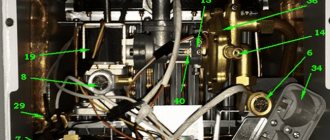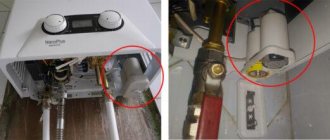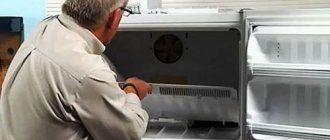How does a gas water heater work?
Two main elements are responsible for heating the water in the column:
- gas-burner;
- the heat exchanger, which is located above it, is a spiral tube through which heated water passes.
The rest of the gas apparatus consists of the following components:
- Ignition. In “prehistoric” Soviet models, this role was played by a wick or igniter, which was lit with a match. Now a piezoelectric element is responsible for this, which only requires the user to press a certain button.
- Water-gas device. Its elements are a gas valve and a membrane installed in the water supply. When you open the water, it starts moving through the column. Due to the water flow, the membrane bends, opening the gas valve, allowing gas to be supplied to the burner.
- The safety automation includes a solenoid valve to which sensors are connected to monitor the uninterrupted operation of the device. If any problems are detected, the sensors instantly close the valve and the column stops working. If we are talking about devices with igniters, then a thermocouple is also attached to the valve, which is heated by the flame. When the burner goes out, it fires.
The geyser goes out: Reasons
There may be several reasons why a geyser goes out. Repairing such a water heating system requires the involvement of qualified specialists. However, there are a number of simple reasons why the water heater may also turn off. The user can install and fix them independently.
If the gas flow heater turns off after ignition, you need to ensure:
- How the pilot light goes out (extraneous sounds may be heard).
- How long after ignition does the burner go out?
The geyser goes out immediately after being turned on
If the water heater turns off immediately after starting, most likely the ionization sensor has failed. It is responsible for the presence of a flame in the burner.
How to understand what the problem is:
- The burner goes out 3-5 seconds after ignition.
- Restarting is accompanied by longer work.
- After a few starts, the equipment begins to function normally.
- After a “rest” the problems recur.
Solution: Inspect the wiring that leads from the sensor to the control board. If everything is in order, the part will need to be replaced.
Ignition and instantaneous extinguishing of the gas water heater
This situation most often occurs due to improper operation of the device by users. When such a water heater is in working condition, it is strictly forbidden to open cold water to dilute hot water. This action is a most dangerous violation of the rules of its use. It can cause serious damage to the device. The temperature of the liquid is regulated solely by supplying gas.
Faulty ignition system
Depending on the models, there are three types of ignition: electric ignition (in modern versions), an igniter, which has a small constant flame, and a hydraulic turbine - from pressure.
The electric ignition runs on built-in batteries. According to manufacturers, they last for about a year. But as practice shows, the service life of such batteries is shorter. For example, in the Bosch gas water heater models W 10 KB or WR 10-2 B, there is an LED on the front panel that indicates the status of the batteries. The Neva Lux range of gas water heaters is also equipped with this type of ignition. If necessary, old batteries are replaced with new ones.
If the cause of the problem is the wick, then it is best to seek help from qualified specialists. They will check the functions of the thermocouple and gas control system, clean and adjust the igniter. Often, the problem when the pilot light of a gas water heater goes out is solved by completely cleaning the water heater.
In the case of a hydroturbine type of ignition, for example, as in the Bosch WRD 13-2 G or WRD 10-2 G, a malfunction may occur due to the lack of water pressure on which it is based.
Microexplosions during ignition
These unpleasant processes are only a consequence of low thrust, unsuitable batteries, contamination of the device itself, or a very large volume of gas supplied to the column. To troubleshoot the problem yourself, the owner can only clean the exhaust duct or replace the batteries. If the problem is not solved, then only gas service employees can understand why the dispenser goes out.
The column lights up normally, but after a few minutes of operation it goes out.
A sensor that reacts to combustion products has triggered. Probably, too many of them have accumulated and they are not displayed. Possible reasons:
The chimney is clogged with soot, soot, and debris.
Reasons: there is no normal traction, the work is not carried out.
Solution: you need to clean the chimney opening on your side. If this does not help, contact the management company.
There is powerful ventilation nearby
Reasons: waste is drawn into the ventilation hole.
Solution: while the column is operating, turn off the ventilation or set the ventilation to minimum power.
Why does the gas water heater turn off by itself?
17 Feb 2014, 08:05
hanan wrote: Hello, similar problem: Ladogaz 10A automatic dispenser, it works for a few minutes and turns off, the hood is good, we tried changing the draft sensor, but it doesn’t help. BUT, if you remove the front panel everything works fine. The gas workers came and couldn’t do anything either. Maybe someone here can tell me?
BUT, if you remove the front panel everything works fine.
This is what we need to push off from. Probably the gas does not burn out completely or a gas pocket is formed, filled with carbon dioxide, and the lack of draft sensor is triggered. This is probably due to the poor design of the speaker itself. You need to figure out where this pocket is and make a planned modernization. Probably the reason is some small thing, because of which the entire product is rejected(
| Geyser is a well-designed technical product for instant water preparation. Since this equipment uses gas (hot carbon monoxide) as fuel, and since carbon monoxide is unsafe for humans, the engineers and designers took care of the safety system. The automatic gas control system “closely monitors” the operation of the dispenser and, at the slightest failure or disruption in operation, will shut off the gas supply, protecting the user from further poisoning. But, like all complex technical products, something can go wrong and the gas control system will turn off the gas water heater for no apparent reason. When contacting our center, clients describe this malfunction as follows: the gas water heater lights up and goes out. Let's take a closer look at this breakdown and the reasons for its occurrence.
|
The speaker turns off during operation
The device turns on, operates for a long period, then turns off. Why the speaker may go out during operation:
- Settings are checked. Probably, automatic shutdown after a certain period was selected.
- Increase in temperature indicators - more than 100 degrees. In this case, the temperature sensor will work and the operation will stop.
- Insufficient pressure in the gas or water supply.
- The contact between the thermocouple and the magnetic valve is broken. Contacts are cleaned and connections are tightened.
- Oxidation of contacts of the control unit. The device begins to click, but the wick does not light. The contacts need to be cleaned.
- The batteries are low. Replaced every 6 months. It is optimal to purchase batteries with a high charge content.
Clogged shower head and hose
It happens that the speaker turns on and immediately goes out when switching to the shower. This is associated with clogging of the watering can. It is necessary to unscrew it, clean it and wash the holes. It is effective to soak metal elements in a solution with citric acid.
Scale on the watering can is formed due to an increase in water hardness in a number of regions. For these purposes, filters are installed or a mixer with a shower is purchased, which is equipped with an integrated anti-scale system.
The next part that sometimes causes the wick to go out is the shower hose. When it gets tangled or clogged, the pressure decreases and the device turns off.
Sometimes the mixer breaks or becomes clogged. It is necessary to disassemble it, check it, and clean it if necessary.
Soot accumulation on the heat exchanger
During operation, the heat exchanger accumulates soot and scale. If it becomes clogged, the color of the fire will change to blue. Cleaning algorithm:
- The casing is removed.
- The screws are unscrewed.
- The water supply is cut off.
- The faucet opens to drain hot water.
- The thread and tap are disconnected.
- A solution of hydrochloric acid is prepared.
- Take a pipe with a diameter of 1/2″ inch or use a hose.
- One end is connected to the input, the other to the output.
- The solution is poured into the funnel.
- When pressure appears at the outlet, the procedure stops.
When working, you must wear gloves. When the scale has been removed, it is necessary to thoroughly flush the heat exchanger to remove acid. Cleaning is recommended once a year. Regular care helps the device function properly.
Traction is poor or completely absent
The accumulation of combustion products is often associated with clogging of the chimney with scale and dirt. If there is no traction or it is not enough, the working out will not be removed.
To check the traction, you need to bring a lit match or lighter to the control window of the device. If the fire deviates to the side, draft is present. If it remains lit, it is missing.
The column does not turn on
If the gas water heater does not turn on, you do not always need to call the experts. There are a number of malfunctions in the gas water heater that the user can repair independently.
Insufficient pressure
The automatic system blocks the gas supply in case of insufficient water pressure. You can estimate the pressure by simply opening the water taps. If it is small or absent altogether, it means that an emergency shutdown in the gas water heater is not due to a breakdown of the device.
In the case of normal pressure in the tap, it is worth looking for reasons in the water heating system. As a rule, a decrease in pressure is a consequence of filter contamination or membrane damage.
During the connection process, some models are equipped with special filters for coarse cleaning, which, when clogged, also significantly affect the strength of the liquid flow.
Coarse filter
To correct the sources of failure due to which the wick of the geyser goes out, the owner will have to:
- clean or change the filtration system;
- install a new membrane partition for the water unit;
- clean the pipeline.
Faulty ignition system
Depending on the models, there are three types of ignition: electric ignition (in modern versions), an igniter, which has a small constant flame, and a hydraulic turbine - from pressure.
The electric ignition runs on built-in batteries. According to manufacturers, they last for about a year. But as practice shows, the service life of such batteries is shorter. For example, in the Bosch gas water heater models W 10 KB or WR 10-2 B, there is an LED on the front panel that indicates the status of the batteries. The Neva Lux range of gas water heaters is also equipped with this type of ignition. If necessary, old batteries are replaced with new ones.
In the case of a hydroturbine type of ignition, for example, as in the Bosch WRD 13-2 G or WRD 10-2 G, a malfunction may occur due to the lack of water pressure on which it is based.
Dirty wick
This problem is typical for speakers with an igniter - very often it can become contaminated with dust. As a result, the fire becomes very weak and turns yellow.
However, a change in the shade of the fire may also indicate that the gas-air mixture contains little air.
This problem leads to the fact that the column either cannot be ignited at all, or it will start working after a large influx of gas. In this case, a pop will be heard first.
You can easily clean the part yourself. To do this, you will need to prepare all the necessary tools - screwdrivers and wrenches. After this, carry out the following sequence of work.
- Unscrew all bolts, remove the cover, dismantle the housing.
- Remove the interfering tubes - to the draft sensor and to the gas supply to the wick.
- Completely disassemble the entire structure by unscrewing the remaining screws.
- Clean and blow through all the parts and put the body back together.
After everything is assembled, you need to check the operation of the column. If the flame ignites the first time and glows blue when burning, it means the cleaning has been done correctly.
How to prevent breakdown?
Preventing igniter problems
The best way out when detecting problems with the igniter is to contact a specialist with a sufficient level of qualifications.
The main thing is to have an official license that allows you to work with gas equipment.
It checks all nodes that could become a source of trouble. And it takes into account the nuances characteristic of a particular type of equipment.
The user himself can only check the traction until emergency service representatives appear on the spot.
To do this, just light a match and bring it to the viewing window. If the flame is drawn inward, it means there is draft and it is sufficient. The chimney pipe is disconnected when there is no movement. Near the opening of the ventilation shafts, the movement with the match is repeated.
Problems with gas leaks are the most serious and complex. It is easy to identify by the presence of a characteristic odor. In this case, you definitely shouldn’t risk trying to fix the problem yourself.
It is better to turn off the gas, ventilate the room, and then call the utility services. Only in this case there is no need to be afraid.
Why does the gas water heater light up and go out, what should I do? The column lights up and immediately goes out - troubleshooting:
See also Phone numbers for consultation July 30, 2021 kasjanenko 863
Share this post
Discussion: there is 1 comment
- Lara says:
10/03/2018 at 00:47The gas water heater requires due attention and you should still be aware that if handled incorrectly, it can explode. I think it's better to call the gas service and sort out the problems.
Answer
The column goes out after ignition
If it was discovered that the column began to fade after ignition, then it is worth paying attention to how this happens: are there any strange sounds, does the igniter go out immediately after being turned on or after some time. A common cause is improper use of the device by users. When such a water heater is in working condition, it is strictly forbidden to open cold water to dilute hot water. This action is a most dangerous violation of the rules of its use. It can cause serious damage to the device. The temperature of the liquid is regulated solely by supplying gas.
Lack of draft in the hood
As a rule, this is caused by a dirty chimney. During operation, combustion products enter it and settle in the form of soot on the walls. Therefore, the ventilation duct requires systematic (once a year) maintenance.
Checking the presence of draft is simple: you need to bring a lit match to the hood. If it functions adequately, the flame should move towards the exhaust path.
Often, a lack of normal draft occurs when plastic windows into a room are tightly closed - they impede the flow of air. During operation, the protective relay overheats, the security system is activated and the device turns off.
Flame ionization sensor malfunction
The fact that the problem is related to the ionization sensor can be understood by the fact that the column goes out almost immediately. The fact is that it is in constant contact with fire, during which ions are produced. They, in turn, are responsible for generating current. And if there are few ions, then the equipment will not turn on normally.
The main signs of a faulty sensor are as follows:
- the burner lights up, but goes out after a couple of seconds;
- If you turn on the column again after this, it will work a little longer;
- the column will light up normally after several consecutive turns on;
- This defect appears when the device is rarely used.
You can try to solve the problem yourself first. To do this, you need to check all the wiring connecting the sensor and the control board. It is important to make sure that all contacts are working properly. After this, unscrew the screws, remove the cover and move the heating electrode closer to the center of the flame. This will extend the life of the part. If these manipulations do not help, then it is better to turn to professionals.
Why the geyser goes out: problems and solutions
When a person adds cold water, the hot water is minimally consumed, so the heat exchanger overheats again. It is necessary to remember that the dosage of hot water is carried out either by a regulator on the column, or by changing the pressure.
Other methods are prohibited.
The flame sensor is triggered immediately when the burner goes out - the fuel supply is blocked. Such cases are rare, but they should not be written off.
This happens if:
The presence of good draft in the chimney is a necessary condition for the normal functioning of the gas water heater.
Other sources of the problem
Let's look at other problems that cause the problem of column attenuation after ignition.
The fading of the wick may be due to the presence of powerful ventilation near the column. Exhaust air is drawn into the ventilation, which leads to attenuation. It is necessary to turn off the ventilation or turn its power down to minimum while the gas heater is operating.
For the same reason, you should not place a powerful hood next to the column. During its operation, sensors may be triggered, diagnosing a malfunction.
Sometimes the reason is hidden in the lack of natural ventilation. It is necessary to open the window or install a supply valve.
The wick can also be extinguished in models with piezo ignition. The button must be held for at least 10 seconds.
“Smart” geysers may not ignite due to a burnt-out control board. They are sensitive to the quality of the electricity supply, so they need to be connected through a stabilizer and not turned off at night
Also, during operation of the heater, it is not recommended to mix hot and cold flows. This leads to a drop in pressure in the line and damping of the wick.
The problem is solved by adjusting the indicators to a comfortable level and reducing the pressure with a special handle. If you still have to mix water, you need to leave the hot stream as the main one.
Attenuation may be caused by a malfunction of the solenoid valve or servomotor. Only calling a specialist will help here.
Why does the geyser go out, how to set it up?
You must hold the button for at least 10 seconds. How to check traction? Place a burning match near the control window or ventilation.
If the flame deviates to the side, there is draft.
If it stays burning evenly, no. Goes out when mixed When a hot flow mixes with a cold one, the pressure in the line drops.
Therefore the wick goes out. Adjust the indicators on the regulator to a comfortable temperature. Reduce the pressure using the special handle.
If you mix water, make sure that the hot stream remains the main one. During operation, the “Neva” or “Astra” column lights up, works for a long time, after which it turns off.
- Check your settings. You may have chosen to automatically turn off after a certain amount of time.
- Poor pressure in the water or gas pipeline.
- Lost contact between thermocouple and solenoid valve.
- Temperature rise - more than 100 degrees. Then the temperature sensor is triggered and the work stops.
Attenuation: overview of popular models
Some brands of water heaters have characteristic diseases that are useful for users to know about. Here are a couple of examples.
Column "Neva 4510"
It happens, although extremely rarely, that this device simply stops turning off.
This occurs due to the jamming of the gas valve rod - the spring cannot move it to the “closed” position.
To check if this is the case, you need to remove the water-gas unit, disconnect the water part from it and try to move the rod with a screwdriver.
If this requires a lot of force, you need to replace the gas unit - this malfunction cannot be repaired (this unit in these columns is too fragile).
Column Bosch Junkers WR 13-P
The weak point of these water heaters is the thermocouple, which is heated by the igniter.
In some units, it quickly (after about 3 years of operation) begins to malfunction, as a result of which the column first goes out spontaneously, and then the igniter cannot be ignited at all - it goes out immediately after the button is released.
This problem can usually be resolved by sanding the thermocouple with fine sandpaper.
If this does not help, check to see if the pilot tube has become dislodged. In the Junkers it is not attached rigidly, and therefore can be moved during cleaning, careless manipulation, or even ignition with a match. As a result, the gap between this tube and the nozzle through which gas is supplied into it is reduced.
Do you think installing a gas water heater is difficult? In fact, installing a geyser with your own hands is quite a feasible task. Everything except the gas line can be done independently.
What is included in the maintenance of a gas boiler, read the following material.
And through this gap air is sucked into the gas flow. Accordingly, the air content in the gas-air mixture decreases, which is why the flame on the igniter burns worse and does not reach the thermocouple. This gap needs to be adjusted. If this is done correctly, the flame on the igniter will lengthen and deviate slightly, reaching the thermocouple.
Ways to prevent malfunctions
When purchasing a device, you should pay attention to the minimum water pressure required for the normal functioning of the device. The passport data must be compared with the water pressure in the apartment.
For the column to work properly, you must:
- carry out preventive maintenance once a year or more often;
- inspect the chimney a couple of times a year and clean it, if necessary;
- clean parts from scale and soot;
- provide adequate ventilation.
And don’t forget to change the batteries on time.










